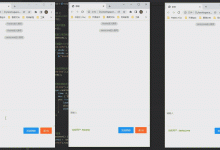Java之初探SpringBoot
About SpringBoot
引用一段狂神的介绍。个人感觉可以理解为是作为SSM的一个优化,将SpringMVC和Spring中繁杂的配置用SpringBoot来代替,减少对于配置的编写和操作,让开发人员更注重于代码本身。
Spring Boot 基于 Spring 开发,Spirng Boot 本身并不提供 Spring 框架的核心特性以及扩展功能,只是用于快速、敏捷地开发新一代基于 Spring 框架的应用程序。也就是说,它并不是用来替代 Spring 的解决方案,而是和 Spring 框架紧密结合用于提升 Spring 开发者体验的工具。
HelloSpringBoot
项目创建
1、创建一个新项目
2、选择spring initalizr , 可以看到默认就是去官网的快速构建工具那里实现
3、填写项目信息
4、选择初始化的组件(初学勾选 Web 即可)
5、填写项目路径
6、等待项目构建成功
项目结构
HellospringbootApplication.java
是这个项目的主启动类,
application.properties
是这个项目的配置文件包括后续需要整合JDBC或者Mybatis时,数据库的配置信息都会在这里。之后写的如controller、service、dao、pojo包都需要在主启动类的同级目录,不然SpringBoot就无法扫描到我们自己编写的业务代码。

Hello SpringBoot Controller
Controller/HelloSpringBootController
@RestControllerpublic class HelloSpringBootController {@RequestMapping("/HelloSpringBoot")public String hello() {return "Hello SpringBoot";}}

项目打jar包
点击maven插件中的package即可,运行完后会在target目录下生成项目jar包

之后也可以通过java -jar的方式在命令行启动项目(SpringBoot自带tomcat)


项目依赖 Pom.xml
<!-- 该项目的父依赖项目,这里才是它版本的控制中心 --><parent><groupId>org.springframework.boot</groupId><artifactId>spring-boot-starter-parent</artifactId><version>2.5.4</version><!-- lookup parent from repository --></parent><groupId>com.zh1z3ven</groupId><artifactId>hellospringboot</artifactId><version>0.0.1-SNAPSHOT</version><name>hellospringboot</name><description>Demo project for Spring Boot</description><dependencies><dependency><groupId>org.springframework.boot</groupId><!-- 启动器spring-boot-starter;springboot-boot-starter-xxx:就是spring-boot的场景启动器spring-boot-starter-web:帮我们导入了web模块正常运行所依赖的组件;SpringBoot将所有的功能场景做成了一个个的starter,需要用哪个就导入依赖即可,也可以自定义starter--><artifactId>spring-boot-starter-parent</artifactId><version>2.5.4</version></dependency><dependency><groupId>org.springframework.boot</groupId><artifactId>spring-boot-starter-test</artifactId></dependency><dependency><groupId>org.springframework.boot</groupId><artifactId>spring-boot-starter-web</artifactId></dependency></dependencies><build><plugins><plugin><!-- 项目打包所需的maven插件 --><groupId>org.springframework.boot</groupId><artifactId>spring-boot-maven-plugin</artifactId></plugin></plugins></build>
主启动类 Application
@SpringBootApplication
注解用来标注这是一个SpringBoot的主启动类,运行时SpringBoot会寻找该类的
main
方法运行整个项目
@SpringBootApplicationpublic class HellospringbootApplication {public static void main(String[] args) {SpringApplication.run(HellospringbootApplication.class, args);}}
引用下狂神对于SpringBoot自动配置的结论
- SpringBoot在启动的时候从类路径下的META-INF/spring.factories中获取EnableAutoConfiguration指定的值
- 将这些值作为自动配置类导入容器 , 自动配置类就生效 , 帮我们进行自动配置工作;
- 整个J2EE的整体解决方案和自动配置都在springboot-autoconfigure的jar包中;
- 它会给容器中导入非常多的自动配置类 (xxxAutoConfiguration), 就是给容器中导入这个场景需要的所有组件 , 并配置好这些组件 ;
- 有了自动配置类 , 免去了我们手动编写配置注入功能组件等的工作;
Yaml配置
上面也提到了,关于SpringBoot是有一个全局配置文件
application.properties
的,这是我们在创建一个SpringBoot项目默认帮我们创建的全局配置文件,但有时候也会用
yaml
去写配置文件(
application.yml
) 如果工程中同时存在application.properties文件和 application.yml文件,yml文件会先加载,而后加载的properties文件会覆盖yml文件。
SpringBoot使用一个全局的配置文件 , 配置文件名称是固定的
-
application.properties
- 语法结构 :key=value
application.yml
- 语法结构 :key:空格 value
示例
.properties
server.prot=8081
.yml
server:port: 8081
About Yaml
相比于xml,yaml语法更简洁也更方便阅读,现在很多的配置文件都在慢慢的用yaml而不是xml。
YAML是 "YAML Ain\’t a Markup Language" (YAML不是一种标记语言)的递归缩写。在开发的这种语言时,YAML 的意思其实是:"Yet Another Markup Language"(仍是一种标记语言)
相关语法
字面量(数字、字符串、布尔)
注意赋值时,在
:
的后面是存在一个
(空格)的,赋值直接写在
:
后即可,默认字符串也不需要用引号包裹。
但是当字符串中出现转义字符如
\\n
时:
- 双引号,不会转义字符串里面的特殊字符 , 特殊字符会作为本身想表示的意思,比如
\\n
就是换行符
- 单引号,会转义特殊字符 , 特殊字符最终会变成和普通字符一样输出,比如
\\n
最后输出就是
\\n
k: v
对象、Map(键值对)
这个有点类似于python中的dict
student:name: zh1z3venage: 3
一行形式:
student: {name: zh1z3ven,age: 3}
数组(List 、set)
用 – 值表示数组中的一个元素
pets:- cat- dog- pig
一行形式:
pets: [cat,dog,pig]
Yaml注入配置文件
首先看下之前用Spring是如何给bean注入属性值的
@Component //注册beanpublic class ADog {@Value("1")private int id;@Value("HanDog")private String name;@Value("-1")private int age;
测试
@SpringBootTestclass HellospringbootApplicationTests {@AutowiredADog aDog;@Testvoid contextLoads() {System.out.println(aDog);}}// ADog{id=1, name=\'HanDog\', age=-1}
通过yml给属性赋值
先写一个类型较全的实体类
@Componentpublic class Person {private String name;private Integer age;private Boolean happy;private Date birth;private Map<String,Object> maps;private List<Object> lists;private ADog aDog;//有参无参构造,get,set,toString}
application.yml
person:name: Zh1z3venage: 18happy: falsebirth: 2005-10-10maps: {this: wuhu,that: qifei}lists:- JavaSE- JavaWeb- SSH- SSM- SMaDog:id: -1name: HanDogage: 16
通过
@ConfigurationProperties(prefix = "person")
将yml配置文件中我们设置的属性值映射到实体类中。
/*@ConfigurationProperties作用:将配置文件中配置的每一个属性的值,映射到这个组件中;告诉SpringBoot将本类中的所有属性和配置文件中相关的配置进行绑定参数 prefix = “person” : 将配置文件中的person下面的所有属性一一对应*/@Component //注册bean@ConfigurationProperties(prefix = "person")public class Person {private String name;private Integer age;private Boolean happy;private Date birth;private Map<String,Object> maps;private List<Object> lists;private ADog aDog;}
测试
@AutowiredPerson person;@Testvoid contextLoads() {//System.out.println(aDog);System.out.println(person);}/*Person{name=\'Zh1z3ven\', age=18, happy=false, birth=Mon Oct 10 00:00:00 CST 2005, maps={this=wuhu, that=qifei}, lists=[JavaSE, JavaWeb, SSH, SSM, SM], aDog=ADog{id=-1, name=\'HanDog\', age=16}}*/
加载指定配置文件
@PropertySource
加载指定配置文件
@configurationProperties
默认从全局配置文件中获取值
与Spring中的属性值注入一样。使用@ConfigurationProperties方式可以进行配置文件与实体字段的自动映射,但需要字段必须提供set方法才可以。
person.properties
name=Zh1z3ven
Person.java
@Component//@ConfigurationProperties(prefix = "person")@PropertySource(value = "classpath:person.properties")public class Person {@Value("${name}")private String name;private Integer age;private Boolean happy;private Date birth;private Map<String,Object> maps;private List<Object> lists;private ADog aDog;
测试类
@SpringBootTestclass HellospringbootApplicationTests {@AutowiredPerson person;@Testvoid contextLoads() {System.out.println(person);}
JSR303数据校验
Springboot中可以用@validated来校验数据,如果数据异常则会统一抛出异常,方便异常中心统一处理。
常见的校验注解
@NotNull(message="名字不能为空")private String userName;@Max(value=120,message="年龄最大不能查过120")private int age;@Email(message="邮箱格式错误")private String email;空检查@Null 验证对象是否为null@NotNull 验证对象是否不为null, 无法查检长度为0的字符串@NotBlank 检查约束字符串是不是Null还有被Trim的长度是否大于0,只对字符串,且会去掉前后空格.@NotEmpty 检查约束元素是否为NULL或者是EMPTY.Booelan检查@AssertTrue 验证 Boolean 对象是否为 true@AssertFalse 验证 Boolean 对象是否为 false长度检查@Size(min=, max=) 验证对象(Array,Collection,Map,String)长度是否在给定的范围之内@Length(min=, max=) string is between min and max included.日期检查@Past 验证 Date 和 Calendar 对象是否在当前时间之前@Future 验证 Date 和 Calendar 对象是否在当前时间之后@Pattern 验证 String 对象是否符合正则表达式的规则
Profile
profile是Spring对不同环境提供不同配置功能的支持,可以通过激活不同的环境版本,实现快速切换环境
多配置文件切换版本
可通过配置文件文件名来标识该配置的版本
application-.properties/yml
application-test.properties 代表测试环境配置application-dev.properties 代表开发环境配置
在.properties中通过设置
spring.profiles.active
属性值来切换
{profile}
版本
spring.profiles.active=dev
yaml多文档块
和properties配置文件中一样,但是使用yml去实现不需要创建多个配置文件
---server:port: 8083spring:profiles: dev #配置环境的名称---server:port: 8084spring:profiles: prod #配置环境的名称
在yaml配置文件中切换版本
#选择要激活那个环境块spring:profiles:active: prod
PS:如果yml和properties同时都配置了端口,并且没有激活其他环境 , 默认会使用properties配置文件的
配置文件加载位置
springboot 启动会扫描以下位置的application.properties或者application.yml文件作为Spring boot的默认配置文件:
优先级1:项目路径下的config文件夹配置文件优先级2:项目路径下配置文件优先级3:资源路径下的config文件夹配置文件优先级4:资源路径下配置文件
默认只要存在配置文件就会按优先级顺序全部加载,各个配置文件会进行互补。
命令行指定配置文件
java -jar spring-boot-config.jar --spring.config.location=F:/application.properties
小结
1、@ConfigurationProperties只需要写一次即可 , @Value则需要每个字段都添加
2、松散绑定:这个什么意思呢? 比如我的yml中写的last-name,这个和lastName是一样的, – 后面跟着的字母默认是大写的。这就是松散绑定。可以测试一下
3、JSR303数据校验 , 这个就是我们可以在字段是增加一层过滤器验证 , 可以保证数据的合法性
4、复杂类型封装,yml中可以封装对象 , 使用value就不支持
SpringBoot整合Mybatis
导入依赖
<dependency><groupId>org.mybatis.spring.boot</groupId><artifactId>mybatis-spring-boot-starter</artifactId><version>2.1.1</version></dependency>
配置数据库连接
Application.yml
spring:datasource:username: rootpassword: 123456#?serverTimezone=UTC解决时区的报错url: jdbc:mysql://localhost:3306/mybatis?serverTimezone=UTC&useUnicode=true&characterEncoding=utf-8driver-class-name: com.mysql.jdbc.Driver
pojo
(也可以使用lombok)
package com.zh1z3ven.hellospringboot.pojo;public class User {private int id;private String name;private String pwd;public User() {}public User(int id, String name, String pwd) {this.id = id;this.name = name;this.pwd = pwd;}public int getId() {return id;}public void setId(int id) {this.id = id;}public String getName() {return name;}public void setName(String name) {this.name = name;}public String getPwd() {return pwd;}public void setPwd(String pwd) {this.pwd = pwd;}@Overridepublic String toString() {return "User{" +"id=" + id +", name=\'" + name + \'\\\'\' +", pwd=\'" + pwd + \'\\\'\' +\'}\';}}
UserMapper.java
创建Mapper接口
@Mapper //标记这是一个Mapper@Repositorypublic interface UserMapper {// 获取所有用户List<User> getUser();}
UserMapper.xml
<?xml version="1.0" encoding="UTF-8" ?><!DOCTYPE mapperPUBLIC "-//mybatis.org//DTD Mapper 3.0//EN""http://mybatis.org/dtd/mybatis-3-mapper.dtd"><mapper namespace="com.zh1z3ven.hellospringboot.mapper.UserMapper"><select id="getUser" resultType="com.zh1z3ven.hellospringboot.pojo.User">select * from user;</select></mapper>
Controller
@Controllerpublic class UserController {@Autowiredprivate UserMapper userMapper;@GetMapping("/getUser")@ResponseBodypublic List<User> getUser() {return userMapper.getUser();}}

写在最后
SM的整合相较于SSM明显简单了很多,少了很多繁杂的配置,且配置都可以写在一起放在properties或者yml中。
简单做个学习记录,熟悉一下SM的整合,后续遇到SpringBoot至少可以上手审计一下。
 爱站程序员基地
爱站程序员基地


